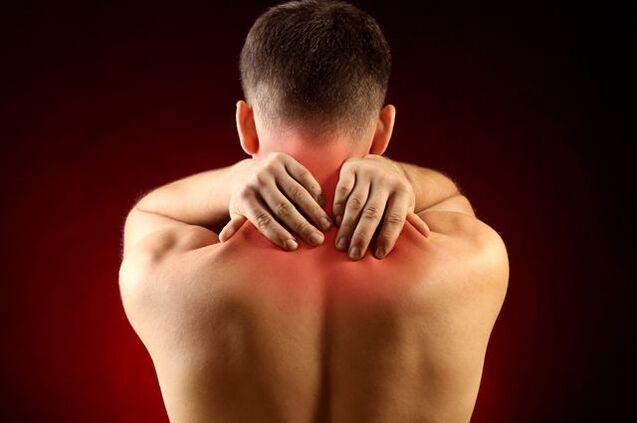Osteochondrosis is a degenerative-dystrophic disease in which the intervertebral disc suffers, with different types of disease, symptoms and treatment methods. The central part of the intervertebral disc (nuclear pulp) first swells and then narrows, losing its shock-absorbing properties. And the annular fibrosis around the disc becomes thin and cracks form inside.
The central part of the intervertebral disc (nuclear pulp) first swells and then narrows, losing its shock-absorbing properties. And the annular fibrosis around the disc becomes thin and cracks form inside.
When the nucleus pulposus leaks into this crack, a protrusion occurs and if the ring breaks, the gelatinous body forms a herniated disc. The risk of developing osteochondrosis increases significantly with age.
It is important
Osteochondrosis may have a different localization. The most common type is lumbosacral (50% of cases). Cervical osteochondrosis is more common (in 25% of cases) and less common in thoracic osteochondrosis. In 12% of cases, the defeat of the intervertebral discs affects several parts of the spine at once - this is the most severe form of the disease.
Regardless of the location, there are several stages of the disease.
1st stageis characterized by instability of the spinal segments, which manifests itself in the violation of the disc.
2nd stageis characterized by less stabilization of the vertebrae due to the elongation of the intervertebral disc. The space between the vertebrae is reduced.
On top3rd stagethere are already serious deformities, such as spinal cord death and intervertebral hernia formation. Pain syndromes and other symptoms largely depend on the location, shape and size of the hernia.
On top4th stagethe patient has difficulty moving, and sudden movements cause severe pain. Sometimes the pain decreases and the person's condition improves, but this is an obvious improvement associated with the growth of bone tissue between the vertebrae that connects only the two vertebrae.
Check yourself
With cervical osteochondrosis there are:
- aching pain in the neck or shoulder blades, pain in the form of a lumbago spread to the back of the head or hands;
- tension in the muscles of the neck, when touched - painful sensations;
- tingling sensation, swelling of the tongue;
- gas throbbing and tingling sensation in the neck and arms;
- weakness of the neck and shoulder muscles.
With osteochondrosis of the thoracic region:
- there are sharp pains from time to time, as if there is a share in the chest;
- there is a feeling of squeezing the chest ring;
- There is intercostal pain during walking. The pain increases with breathing and does not go away after taking nitroglycerin, but is generally short-lived.
Osteochondrosis of the lumbosacral region is characterized by:
- pain in the lower back, sometimes it is impossible to straighten the back;
- pain in the legs, sacrum, groin;
- loss of sensitivity of the legs, impaired mobility;
- cold feet, goose bumps and tingling.
Note
Many people think that sciatica is an independent disease. In fact, it is one of the manifestations of osteochondrosis. Damage to the intervertebral disc causes adjacent vertebrae to come closer together and disrupt bundles of nerve fibers extending from the spinal cord. A herniated disc can also compress nerve roots. In this case, there is pain that spreads along certain nerve fibers and therefore extends to one or another part of the body, most of the back and legs, less to the neck or arms. .
There is also the term "lumbago". This is the name of the sharp pain in the lower back. It can occur with a sharp movement, lifting weights, a failed turn, prolonged stay in an uncomfortable position. During an attack, a person often takes a forced position, any attempt to move increases the pain, often develops spasms of the muscles of the lumbar region. Lumbago is most often caused by osteochondrosis of the spine.
Risk factors
Tall people with weak posture or weakness of the back and abdominal muscles are prone to osteochondrosis; fat; office workers who lead a sedentary lifestyle in most cases, as well as carriers and construction workers who often carry heavy loads. It is also common for professional drivers who have been exposed to vibration for a long time.
Improper exercise can lead to osteochondrosis. The disease often overwhelms former professional athletes who have suddenly completed strenuous training.
Osteochondrosis is more dangerous than it seems. It often causes dysfunction of many organs and systems. Sometimes the disease causes severe excruciating pain and constriction of the nerve roots - partial or complete paralysis of the arm or leg.
Left untreated, cervical lumbar osteochondrosis can cause dizziness, headaches, and insomnia. Initiated thoracic osteochondrosis is fraught with complications such as intercostal neuralgia. Lumbar osteochondrosis is dangerous with consequences such as progressive curvature of the spine and greater destruction of the intervertebral discs, inflammation of the sciatic nerve (sciatica), serious disturbances in the functioning of the organs of the genitourinary system.
Patient memory
Conservative treatment is often used to treat exacerbations of osteochondrosis. Its main purpose is to relieve pain and relieve reflex muscle tension and stiffness caused by pain. Non-steroidal anti-inflammatory drugs and muscle relaxants are used for this purpose.
In addition, medications are used to help speed recovery: B vitamins, substances that improve the blood supply to the spine and nourish the nerve roots, biostimulants, as well as sedatives that support the nervous system, tired from prolonged pain.
Physiotherapeutic methods are used to improve blood circulation and reduce tissue edema, stimulate muscles: magnetic and ultrasound therapy, phono and electrophoresis, darsonvalization, electromyostimulation. Acupuncture, manual therapy, massage, mud applications are also used.
Traction therapy is used to loosen the spine and increase the distance between the vertebrae. A successful recovery prognosis is not possible without physiotherapy exercises that actively involve the patient in the treatment process.
Surgical treatment is used in severe, advanced cases.






















